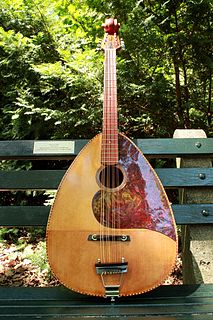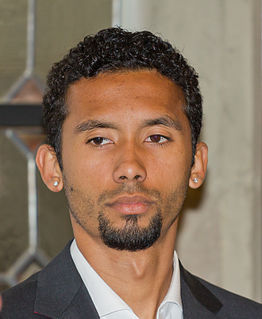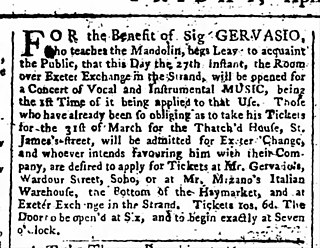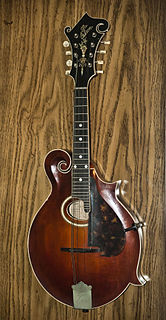Related Research Articles
A mandolin is a stringed musical instrument in the lute family and is generally plucked with a plectrum. It most commonly has four courses of doubled metal strings tuned in unison, thus giving a total of 8 strings, although five and six course versions also exist. The courses are typically tuned in a interval of perfect fifths, with the same tuning as a violin. Also like the violin, it is the soprano member of a family that includes the mandola, octave mandolin, mandocello and mandobass.

Milton Nascimento is a prominent Brazilian singer-songwriter and guitarist.

Orville H. Gibson was a luthier who founded the Gibson Guitar Company in Kalamazoo, Michigan in 1902, makers of guitars, mandolins and other instruments.

The mandocello is a plucked string instrument of the mandolin family. It is larger than the mandolin, and is the baritone instrument of the mandolin family. Its eight strings are in four paired courses, with the strings in each course tuned in unison. Overall tuning of the courses is in fifths like a mandolin, but beginning on bass C (C2). It can be described as being to the mandolin what the cello is to the violin.

The bandurria is a plucked chordophone from Spain, similar to the mandolin, primarily used in Spanish folk music, but also found in former Spanish colonies.

Bernardo De Pace was an actor, musician and comedic vaudeville entertainer of the 1910s and 1920s, billed as "the Wizard of the Mandolin". He learned to play mandolin in the Italian tradition under Francesco Della Rosa. De Pace's repertoire and technique was described in the Brooklyn Life as involving "the most difficult violin and piano compositions, executed at inconceivably rapid tempi demanding an uncanny technique seldom heard on fretted instruments". In 1927 the Minneapolis Star said that he had been recognized as one of the best mandolinists in the United States. It added that he was more than a mandolinist, that his skill was in playing on human emotions as few musicians were able.

Hamilton de Holanda is a Brazilian bandolinist known for his mixture of choro and contemporary jazz, and for his instrumental virtuosity. Born in Rio de Janeiro he moved to Brasilia with his family as a boy. He started playing the mandolin at 5 and appeared at his first performance at six. With his brother Fernando César he formed the group Dois de Ouro and throughout his career he has collaborated with many other significant artists such as Yamandu Costa, Mike Marshall and Joel Nascimento. He has received several Latin Grammys. He has taught at the Raphael Rabello Choro academy. He plays a custom made 10 string Bandolim.

Bruno Andrade de Toledo Nascimento is a Brazilian professional footballer who plays as a central defender for Manama Club in Bahrain.

Antonio Luigi Embergher was an Italian Luthier known for his high quality bowlback mandolins.

A mandolone is a member of the mandolin family, created in the 18th century. It is a bass range version of the Neapolitan mandolin. Its range was not as good as the mandocello, which replaced it in mandolin orchestras, and had largely disappeared in the 19th century.
Filipe Guterres Nascimento is a Portuguese professional footballer who plays as a central midfielder.
Evan Marshall is a virtuoso mandolinist, prominent as an arranger of classical music pieces for the mandolin and proponent of the duo style of playing. His name comes up in mandolin-oriented music circles as one of the best of modern mandolin players, one who has taken the techniques of early mandolin soloists to new levels. He is also a recording artist with Rounder Records and teaches mandolin. He has given classes for the Classical Mandolin Society of America, the Mandolin Symposium and the American Mandolin and Guitar Summer School, and has been associated with the Conservatory of Music at Biola University. As a performer, he has worked as a featured guest with several symphony orchestras, including the Houston Symphony, Phoenix Symphony, and Buffalo Philharmonic Orchestra. He is a former member of Billy Hill and the Hillbillies.

Pasquale Vinaccia was an Italian luthier, appointed instrument-maker for the Queen of Italy, and maternal grandfather to Carlo Munier. In 1835 he improved the mandolin, creating a version of the instrument that used steel wires for strings, known today as the "Neapolitan Mandolin." His use of steel strings has become the dominant way of stringing mandolins.

Giovanni Vailati was an Italian mandolinist who reached the virtuosic-level of playing ability and was able to travel and perform throughout Europe. Entirely self taught on his instrument, he was described by Philip J. Bone as a "natural genius on his instrument, who by his remarkable performances, became known throughout his native land as 'Vailati the blind, the Paganini of the mandolin.'" He is important as one the first generations of quality performers to use mandolin. He was one of a small number of mandolinists of the 19th century to play the mandolin in the concert halls of Europe after the Napoleonic War, who played with excellence in spite of indifference and diffidence toward their chosen instrument. Pietro Vimercati was another, whose concerts predated Vailati's by about 30 years. Also performing in Europe in the years following 1815 was Luigi Castellacci.

Giovanni Battista Gervasio was an Italian musician and composer. Born in Naples he was one of the first generation of virtuoso-mandolinists who left Italy and played the mandolin in Europe in the 18th century. He was a composer for the mandolin and his works can be found scattered in 18th century collections such as the Gimo music collection and the Bibliothèque Nationale de France. He also wrote a mandolin method Methode facile pour apprendre a quatre cordes, instrument pour les dames, published in Paris in 1767. He performed in London 1768 and in Frankfurt-on-the-Main in December 10, 1777 and the Concert Spirituel in Paris on December 24, 1784. He advertised in 1785 that he was master of singing and mandolin to Her Royal Highess, the Princess of Prussia. A work of music addressed to her exists today in the Bibliothèque Nationale de France.

The mandolin has had a place in North American culture since the 1880s, when a "mandolin craze" began. The continent was a land of immigrants, including Italian immigrants, some of whom brought their mandolins with them. In spite of the mandolin having arrived in America, it was not in the cultural consciousness until after 1880 when the Spanish Students arrived on their international performing tour. Afterwards, a "mandolin craze" swept the United States, with large numbers of young people taking up the instrument and teachers such as Samuel Siegel touring the United States. The fad died out after World War I, but enough had learned the instrument that it remained. The mandolin found a new surge with the music of Bill Monroe; the Gibson F-5 mandolin he played, as well as other archtop instruments, became the American standard for mandolins. Bowlback mandolins were displaced. The instrument has been taken up in blues, bluegrass, jug-band music, country, rock, punk and other genres of music. While not as popular as the guitar, it is widespread across the country.

The mandolin is a modern member of the lute family, dating back to Italy in the 18th century. The instrument was played across Europe but then disappeared after the Napoleonic Wars. Credit for creating the modern bowlback version of the instrument goes to the Vinaccia family of Naples. The deep bowled mandolin, especially the Neapolitan form, became common in the 19th century, following the appearance of an international hit, the Spanish Students. They toured Europe and America, and their performances created a stir that helped the mandolin to become widely popular.

Following its invention and development in Italy the mandolin spread throughout the European continent. The instrument was primarily used in a classical tradition with mandolin orchestras, so called Estudiantinas or in Germany Zupforchestern, appearing in many cities. Following this continental popularity of the mandolin family, local traditions appeared outside Europe in the Americas and in Japan. Travelling mandolin virtuosi like Carlo Curti, Giuseppe Pettine, Raffaele Calace and Silvio Ranieri contributed to the mandolin becoming a "fad" instrument in the early 20th century. This "mandolin craze" was fading by the 1930s, but just as this practice was falling into disuse, the mandolin found a new niche in American country, old-time music, bluegrass and folk music. More recently, the Baroque and Classical mandolin repertory and styles have benefited from the raised awareness of and interest in Early music, with media attention to classical players such as Israeli Avi Avital, Italian Carlo Aonzo and American Joseph Brent.
References
- ↑ "Músicos do Brasil: Uma Enciclopédia Instrumental". Archived from the original on 2016-04-03. Retrieved 2016-10-08.
- ↑ "Joel Nascimento". CliqueMusic. UOL. Retrieved 30 May 2014.
- ↑ "Joel Nascimento (biografia)". Cravo Albin da MPB. Retrieved 30 May 2014.
- ↑ Sparks, Paul (1995). The Classical Mandolin. Oxford: Clarendon Press. p. 182. ISBN 978-0-19-517337-6.
| | This article on a Brazilian musician is a stub. You can help Wikipedia by expanding it. |